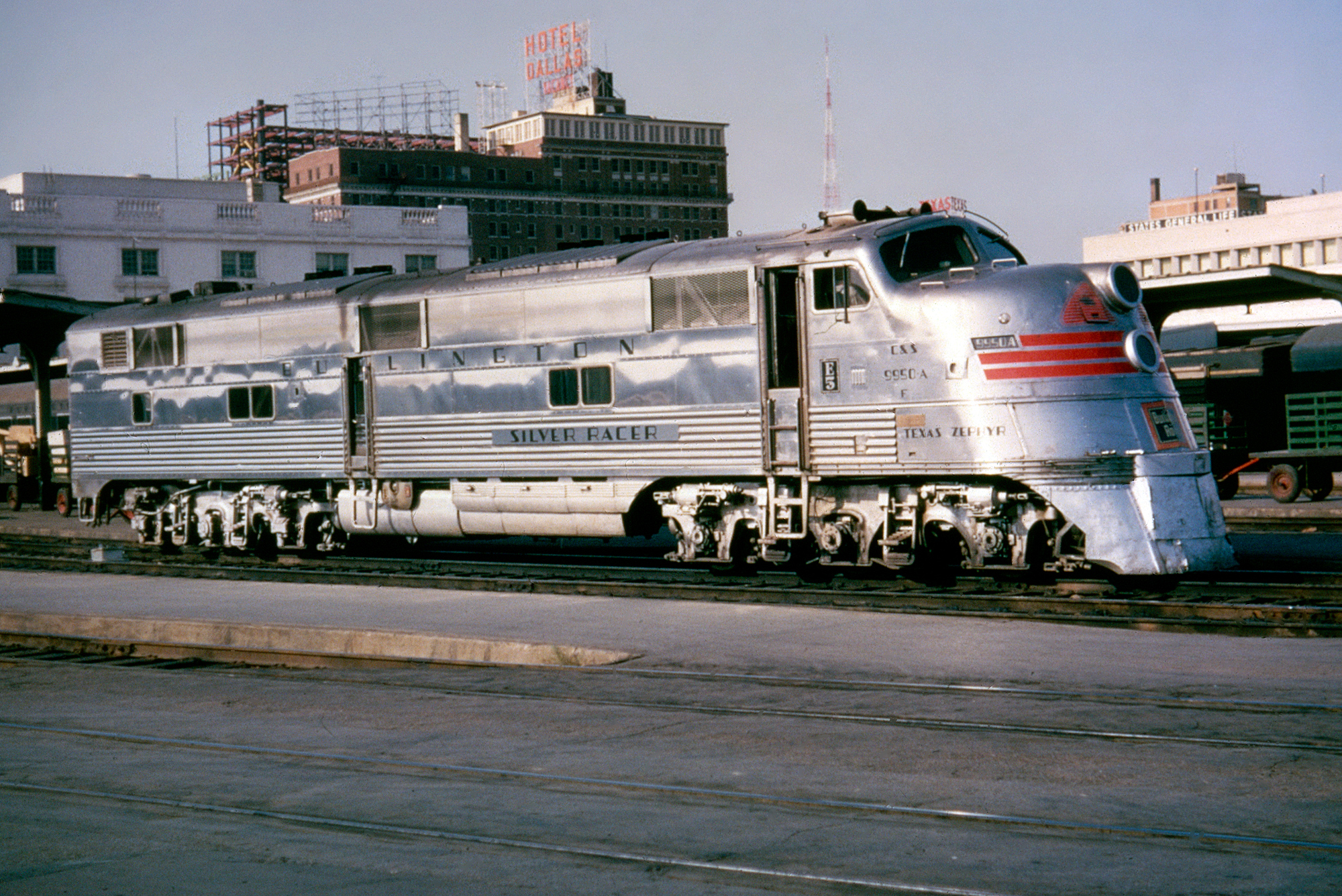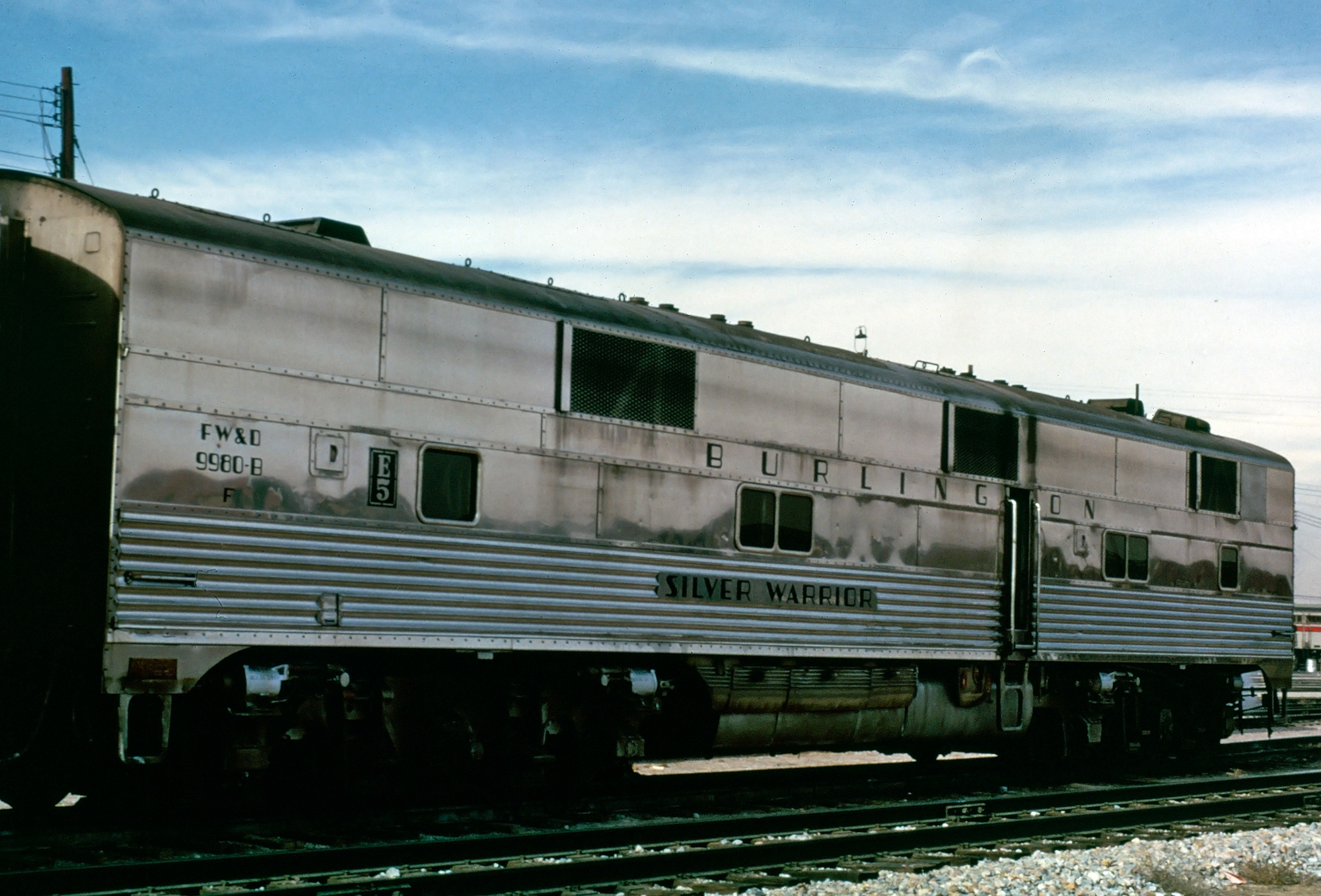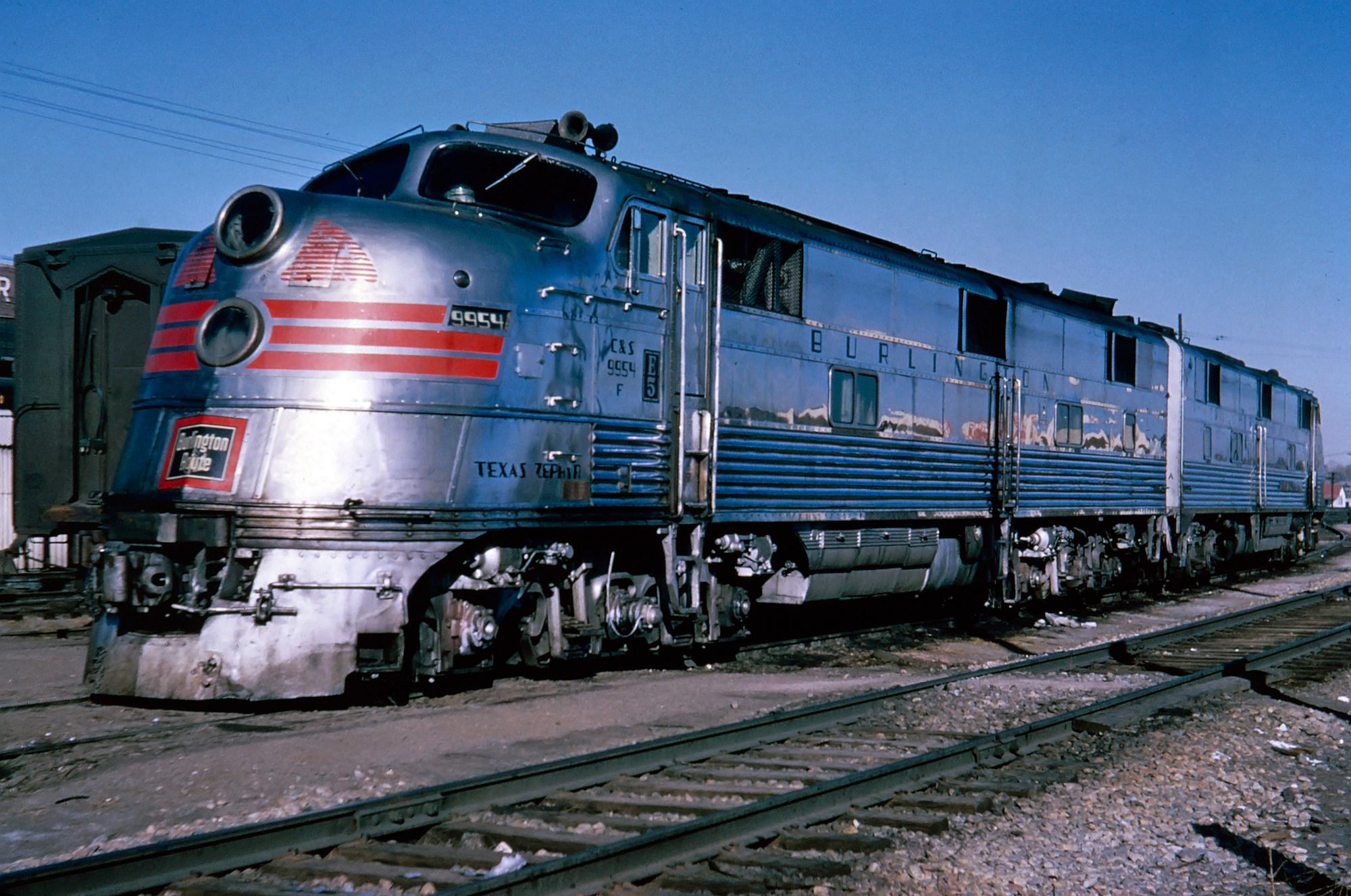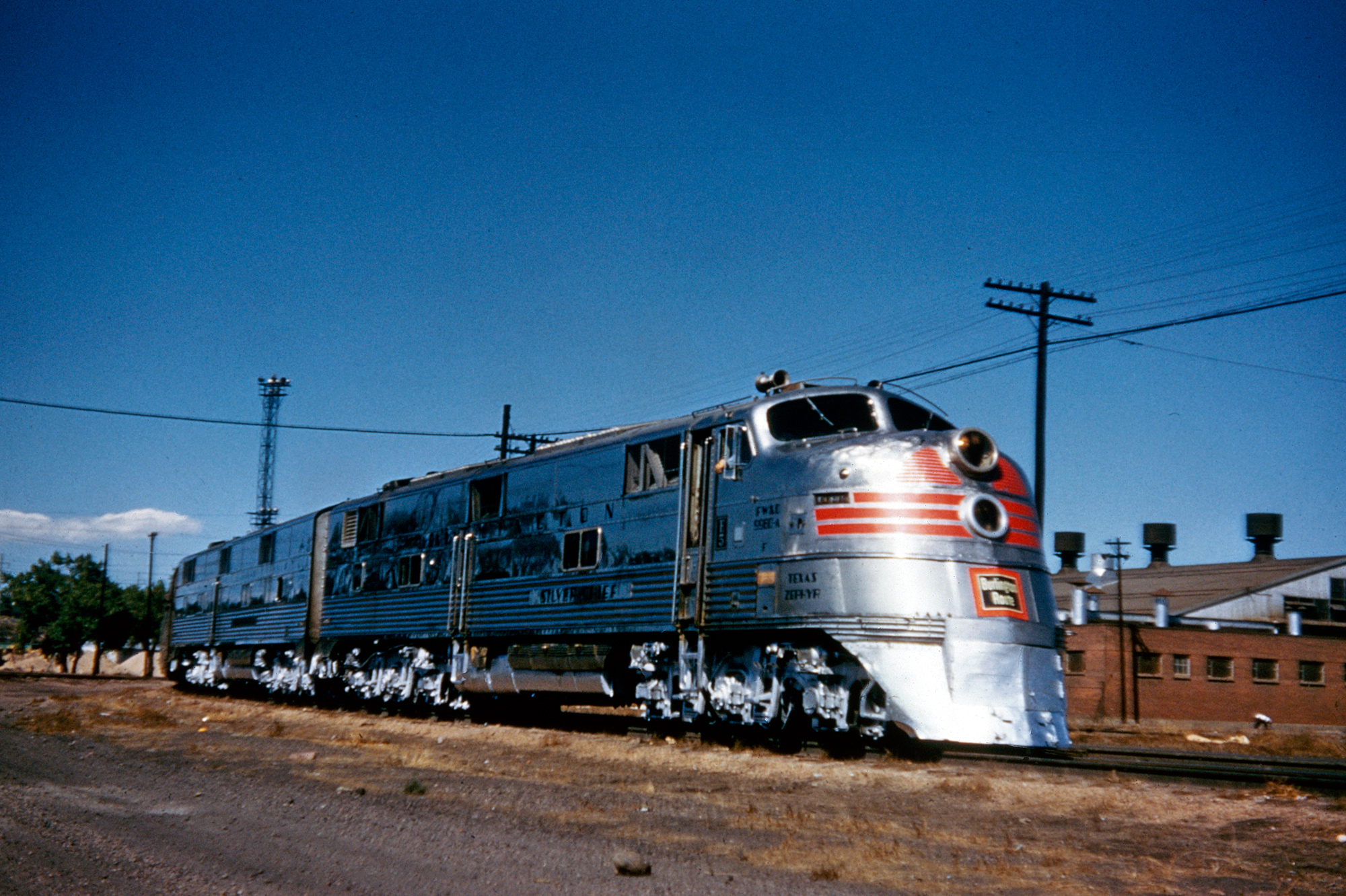EMD "E5" Locomotives: Data, Specs, Roster
Last revised: December 19, 2024
By: Adam Burns
The E5 was a variant of Electro-Motive's passenger line produced specifically for the Chicago, Burlington & Quincy or its subsidiaries.
Internally, it was virtually identical to every other E model save for its relatively new GM prime mover. Externally, the only significant change from previous designs then cataloged was the addition of fluted stainless steel, a trademark of both the Burlington's passenger trains and the Budd Company.
Photos
 Chicago, Burlington & Quincy (Colorado & Southern) E5A #9950-A, named the "Silver Racer" and one of the lead units for the "Texas Zephyr," is seen here at Dallas Union Station during the 1950s. American-Rails.com collection.
Chicago, Burlington & Quincy (Colorado & Southern) E5A #9950-A, named the "Silver Racer" and one of the lead units for the "Texas Zephyr," is seen here at Dallas Union Station during the 1950s. American-Rails.com collection.Overview
Internally, the E5 was virtually identical to its future cousin, the E6. It carried two 567 prime movers capable of a combined 2,000 horsepower and A1A-A1A trucks.
It featured a few ornamental differences, most notably fluted stainless steel to match the Budd Company equipment. Today, #9911A (the Silver Pilot) is preserved and operable at the Illinois Railway Museum, using an original consist of equipment.
The E5 began production in early 1940. It was ordered by the CB&Q to power the railroad's new Zephyr passenger train fleet which included names like the Afternoon Zephyr, Morning Zephyr, Nebraska Zephyr, Ak-Sar-Ben Zephyr, and the American Royal Zephyr.
Per Electro-Motive's common practice for passenger models, the E5 used an A1A-A1A truck setup (meaning the center axle was unpowered) and featured two GM model 567 prime movers; combined these could produce 2,000 horsepower.
Additionally, using four of GM's standard model D7 traction motors the E5 offered 56,500 pounds of starting tractive effort and 31,000 pounds continuous.
Once again, EMC gave the E5 a "slant nose" design, commonly used on the E3 and E4, which disappeared entirely following the E6 as both E and F models used the classic "bulldog" design.
 Fort Worth & Denver (Burlington) E5B #9980-B, named the "Silver Warrior." American-Rails.com collection.
Fort Worth & Denver (Burlington) E5B #9980-B, named the "Silver Warrior." American-Rails.com collection.Production of the EMC E5 ran through mid-1941 and although the design was manufactured for over a year only 11 E5As and 5 E5Bs were built.
The CB&Q first began receiving its locomotives in February and March of 1940 when E5A's 9910A-9912A, 9909, and Fort Worth & Denver City 9980A arrived along with E5Bs 9910B-9912B, Colorado & Southern 9950B, and Fort Worth & Denver City 9980B.
 Burlington (Colorado & Southern) E5A #9954 (built as CB&Q #9913, named the "Silver Wings"), and other power, layover at Colorado Springs, Colorado, circa 1960. American-Rails.com collection.
Burlington (Colorado & Southern) E5A #9954 (built as CB&Q #9913, named the "Silver Wings"), and other power, layover at Colorado Springs, Colorado, circa 1960. American-Rails.com collection.That concluded its order of B units but another A arrived in October of that year, CB&Q 9913. Finally, in June of 1941 just months before the United State entered World War II A units 9914A, 9914B, 9915A, and 9915B arrived completing the order.
The Burlington apparently really liked their E5s as they remained in service all of the way through the 1960s although some units were retired prior to that time.
Data Sheet and Specifications
| Entered Production | 2/1940 (Chicago, Burlington & Quincy #9910-A) |
| Years Produced | 2/1940 - 6/1941 |
| Engine | 567 (2) |
| Engine Builder | GM |
| Horsepower | 2000 |
| RPM | 800 |
| Cylinders | 12 |
| Length | 71' 1 ¼" |
| Height (Top Of Rail To Top Of Cab) | 13' 11" |
| Height (Top Of Rail To Top Of Roof Horn) | 14' 0" |
| Width | 10' 7" |
| Weight | 315,000 Lbs (A Units): 290,000 Lbs (B Units) |
| Fuel Capacity | 1,200 Gallons |
| Air Compressor | Gardner-Denver |
| Air Compressor Model | WBO |
| Air Brake Manufacturer | Westinghouse |
| Air Brake Schedule | HSC |
| Trucks | A1A |
| Truck Type | Blomberg |
| Truck Wheelbase | 14' 1" |
| Wheel Size | 36" |
| Steam Generator Manufacturer | Vapor-Clarkson |
| Steam Generator Capacity | 1200 Lbs/Hr |
| Traction Motors | D7 (4), GM |
| Primary Generator | D4 (2), GM |
| Auxiliary Generator | Delco |
| MU (Multiple-Unit) | Yes |
| Dynamic Brakes | No |
| Gear Ratio | 52:15 |
| Tractive Effort (Starting) | 56,500 Lbs at 25% |
| Tractive Effort (Continuous) | 31,000 Lbs at 11 mph |
| Top Speed | 116 mph |
Production Roster
E5A
Total Built = 11
| Owner | Road Number | Serial Number | Order Number | Completion Date | Quantity |
|---|---|---|---|---|---|
| Chicago, Burlington & Quincy | 9910A-9912A, 9909 | 967-970 | E278 | 2/1940-3/1940 | 4 |
| Colorado & Southern | 9950A | 1035 | E278 | 3/1940 | 1 |
| Fort Worth & Denver City | 9980A | 1036 | E278 | 3/1940 | 1 |
| Chicago, Burlington & Quincy | 9913 | 1133 | E331 | 10/1940 | 1 |
| Chicago, Burlington & Quincy | 9914A-9915A, 9914B-9915B | 1301-1304 | E377 | 6/1941 | 4 |
E5B
Total Built = 5
| Owner | Road Number | Serial Number | Order Number | Completion Date | Quantity |
|---|---|---|---|---|---|
| Chicago, Burlington & Quincy | 9910B-9912B | 971-973 | E279 | 2/1940-3/1940 | 3 |
| Colorado & Southern | 9950B | 1037 | E279 | 3/1940 | 1 |
| Fort Worth & Denver City | 9980B | 1038 | E279 | 3/1940 | 1 |
In many ways, the E5 was simply a variant design as the company had already began production on the E6 in 1939 that coincided with the release of its publicly successful FT model used in freight service.
The E6 sold more than 100 A an B units and the following E7 and E8 designs outshopped more than 1,000 altogether.
Locomotive Names
"A" Units
(Cabs)
| Road Number | Name | Date Built | Disposition |
|---|---|---|---|
| 9909 (CB&Q) | Silver Bullet | 3/1940 | Colorado & Southern 9953 (11/9/1955), EMD Trade-In (3/15/1968) |
| 9910-A (CB&Q) | Silver Speed | 2/1940 | Colorado & Southern 9951-A (7/14/1955), EMD Trade-In (10/31/1967) |
| 9911-A (CB&Q) | Silver Pilot | 2/1940 | Fort Worth & Denver #9982-A (6/1/1955), Colorado & Southern 9952-A (10/1/1955), Illinois Railway Museum |
| 9912-A (CB&Q) | Silver Meteor | 3/1940 | GE Trade-In (3/1965) |
| 9913 (CB&Q) | Silver Wings | 10/1940 | Colorado & Southern 9954 (4/25/1957), EMD Trade-In (3/15/1968) |
| 9914-A (CB&Q) | Silver Arrow | 6/1941 | Colorado & Southern 9955 (9/20/1961), EMD Trade-In (3/15/1968) |
| 9914-B (CB&Q) | Silver Swift | 6/1941 | Wrecked (8/22/1960) |
| 9915-A (CB&Q) | Silver Carrier | 6/1941 | Wrecked (4/22/1963), GE Trade-In (3/1965) |
| 9915-B (CB&Q) | Silver Clipper | 6/1941 | GE Trade-In (3/1965) |
| 9950-A (C&S) | Silver Racer | 3/1940 | EMD Trade-In (3/15/1968) |
| 9980-A (FW&D) | Silver Chief | 3/1940 | Scrapped |
"B" Units
(Cabless)
| Road Number | Name | Date Built | Disposition |
|---|---|---|---|
| 9910-B (CB&Q) | Silver Power | 2/1940 | Scrapped |
| 9911-B (CB&Q) | Silver Mate | 3/1940 | Scrapped |
| 9912-B (CB&Q) | Silver Comet | 3/1940 | Scrapped |
| 9914-B (CB&Q) | Silver Swift | 3/1940 | Scrapped |
| 9950-B (C&S) | Silver Steed | 3/1940 | Trade-In (10/1967) |
| 9980-B (FW&D) | Silver Warrior | 3/1940 | Scrapped |
 Chicago, Burlington & Quincy E5A #9980-A, named the "Silver Chief," has the "Texas Zephyr" in Fort Worth, Texas during the 1950s. American-Rails.com collection.
Chicago, Burlington & Quincy E5A #9980-A, named the "Silver Chief," has the "Texas Zephyr" in Fort Worth, Texas during the 1950s. American-Rails.com collection.By the time the war had ended EMD was fully entrenched as the leader of the diesel locomotive market pulling away from the American Locomotive Company whose beautiful but mechanically trouble-prone PA fell behind the E series in sales and interest.
General Motors' subsidiary would soon begin to dominate the industry by the 1950s releasing models like the GP7 and GP9.
In any event, as mentioned above one of these beautiful locomotives was preserved, #9911A, which resides at the Illinois Railway Museum. It is occasionally operates and has even been featured in movies (notably "A League of Their Own" and "Flags of Our Fathers").
Sources
- Hayden, Bob. Diesel Locomotives: Cyclopedia, Volume 2 (Model Railroader). Milwaukee: Kalmbach Publishing Company, 1980.
- Marre, Louis A. Diesel Locomotives: The First 50 Years, A Guide To Diesels Built Before 1972. Milwaukee: Kalmbach Publishing Company, 1995.
- Pinkepank, Jerry A. Diesel Spotter's Guide. Milwaukee: Kalmbach Publishing Company, 1967.
- Solomon, Brian. EMD Locomotives. Minneapolis: MBI Publishing Company, 2006.
- Solomon, Brian. Electro-Motive E-Units and F-Units: The Illustrated History of North America's Favorite Locomotives. Minneapolis: Voyageur Press, 2011.
Contents
Recent Articles
-
Indiana - Whiskey - Train Rides
Dec 23, 25 06:40 PM
Whether you're a local resident or a traveler looking to explore Indiana from a unique perspective, hopping on a whiskey train ride is a journey worth considering. -
California - Wine Tasting - Train Rides
Dec 23, 25 06:33 PM
This article explores the charm, routes, and offerings of these unique wine tasting trains that traverse California’s picturesque landscapes. -
Alabama - Wine Tasting - Train Rides
Dec 23, 25 06:26 PM
While the state might not be the first to come to mind when one thinks of wine or train travel, the unique concept of wine tasting trains adds a refreshing twist to the Alabama tourism scene.



